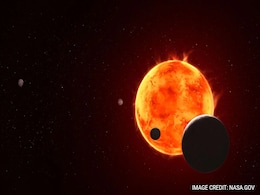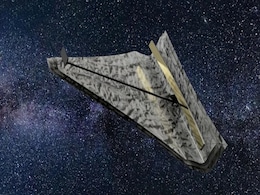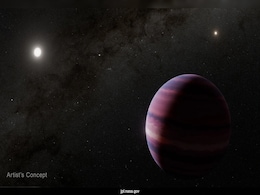Planet Exoplanet
- All
- News
- Videos
- Web Stories
-

Astronomers Spot First Coronal Mass Ejection from a Distant Star, Raising Questions About Planetary Habitability
- Monday November 17, 2025
- Written by Gadgets 360 Staff
Astronomers detected the first coronal mass ejection from a distant star, revealing that powerful stellar eruptions may strip atmospheres from nearby planets, affecting exoplanet habitability and the search for life.
-
 www.gadgets360.com
www.gadgets360.com
-

Planets Could Create Their Own Water While Forming, Expanding Possibilities for Habitable Worlds
- Tuesday November 11, 2025
- Written by Gadgets 360 Staff
Lab experiments show planets can generate water during formation, not just via comets. This suggests habitable conditions may be widespread in the galaxy, expanding possibilities for life-friendly exoplanets.
-
 www.gadgets360.com
www.gadgets360.com
-

NASA's James Webb Space Telescope Telescope Challenges Old Theories on Mini-Neptune Worlds
- Friday November 7, 2025
- Written by Gadgets 360 Staff
New models suggest mini-Neptunes—planets smaller than Neptune with thick gas envelopes—may have solid rocky surfaces instead of molten magma. Data from NASA’s JWST revealed high-pressure atmospheres capable of compressing molten rock into solid crusts. This discovery challenges earlier assumptions and offers key insights into exoplanet compos...
-
 www.gadgets360.com
www.gadgets360.com
-

NASA’s JWST Produces First-Ever 3D Map of Distant Planet WASP-18b
- Monday November 3, 2025
- Written by Gadgets 360 Staff
NASA’s James Webb Space Telescope has created the first-ever 3D atmospheric map of an exoplanet, revealing the extreme conditions on WASP-18b, an “ultra-hot Jupiter” located 400 light-years away. Using infrared eclipse mapping, scientists discovered a scorching hotspot over 2,700 °C where water molecules are breaking apart. This groundbreaki...
-
 www.gadgets360.com
www.gadgets360.com
-

Astronomers Stunned By Three Earth-Sized Planets In Distant Unique Planetary System
- Wednesday October 29, 2025
- Science | Edited by Srishti Singh Sisodia
The study revealed that TOI-2267 has two closely bound stars orbiting each other, and the third planet transits the companion star.
-
 www.ndtv.com
www.ndtv.com
-

Possible 'Super-Earth' Discovered Just 20 Light-Years Away, Say Scientists
- Saturday October 25, 2025
- Science | Edited by Nikhil Pandey
The rocky exoplanet is nearly four times Earth's mass and may offer new insights in the search for habitable worlds.
-
 www.ndtv.com
www.ndtv.com
-

Astronomers Capture First-Ever Image Of A Baby Planet Forming In Real Time
- Tuesday October 7, 2025
- Science | Edited by Nikhil Pandey
Astronomers have made a groundbreaking discovery by directly observing a young protoplanet, WISPIT 2b, embedded in a ring-shaped gap in a disk around a young star.
-
 www.ndtv.com
www.ndtv.com
-

Not Like Venus Or Mars, Distant Exoplanet May Have Atmosphere Like Earth's
- Friday September 19, 2025
- World News | Edited by NDTV News Desk
A distant exoplanet might have an atmosphere similar to Earth's, early observations from the James Webb Space Telescope (JWST) suggest. It is part of a group of planets orbiting a star called TRAPPIST-1, about 40 light-years away from Earth.
-
 www.ndtv.com
www.ndtv.com
-

Diamond 'Super-Earth' May Not Be Quite as Precious as Once Thought, Study Finds
- Monday September 8, 2025
- Written by Gadgets 360 Staff
New research challenges the idea that 55 Cancri e, once dubbed a “diamond planet”, is rich in carbon. Re-analysing telescope data, scientists concluded that the host star has a lot more oxygen than originally believed, making the possibility that its planet formed with a carbon-dominant atmosphere less likely.
-
 www.gadgets360.com
www.gadgets360.com
-

Exoplanets Explained: How Astronomers Find Worlds Orbiting Stars Beyond the Sun
- Monday September 8, 2025
- Written by Gadgets 360 Staff
Exoplanets are planets orbiting stars outside our solar system, hidden by stellar glare and detected indirectly. Astronomers identify them by tracking star wobbles or dips in brightness during planetary transits. NASA’s Kepler mission revealed thousands, with TESS now expanding the search. These discoveries confirm that planetary systems are abun...
-
 www.gadgets360.com
www.gadgets360.com
-

Astronomers Propose Rectangular Telescope to Hunt Earth-Like Planets
- Tuesday September 2, 2025
- Written by Gadgets 360 Staff
Astronomers are exploring a revolutionary space telescope design with a long, narrow primary mirror instead of a traditional circular one. A 20×1 m rectangular mirror concentrates resolution along its length, enabling it to separate Earth-like planets from their stars at ~30 light-years in infrared light. Rotating the telescope 90° captures plane...
-
 www.gadgets360.com
www.gadgets360.com
-

Breakthrough Photo: See The 'Birth' Of A Planet For The Very First Time
- Friday August 29, 2025
- Science | Edited by Nikhil Pandey
A team of astronomers has detected for the first time a planet outside our solar system, embedded in a cleared gap of a multi-ringed disc.
-
 www.ndtv.com
www.ndtv.com
-

NASA Telescope Detects Possible Signs Of Alien Life On Distant 'Water World'
- Wednesday August 27, 2025
- Science | Edited by Nikhil Pandey
Researchers using the Webb telescope found traces of two gases, dimethyl sulfide (DMS) and dimethyl disulfide (DMDS), in the atmosphere of K2-18b, a planet 124 light-years away.
-
 www.ndtv.com
www.ndtv.com
-

A New 'Earth' Next Door? Scientists Detect Possible Habitable Planet Around Closest Sun-Like Star
- Friday August 15, 2025
- Science | Edited by Nikhil Pandey
Astronomers using JWST have detected a giant exoplanet in the habitable zone of Alpha Centauri A, our nearest Sun-like star.
-
 www.ndtv.com
www.ndtv.com
-

Astronomers Spot First Coronal Mass Ejection from a Distant Star, Raising Questions About Planetary Habitability
- Monday November 17, 2025
- Written by Gadgets 360 Staff
Astronomers detected the first coronal mass ejection from a distant star, revealing that powerful stellar eruptions may strip atmospheres from nearby planets, affecting exoplanet habitability and the search for life.
-
 www.gadgets360.com
www.gadgets360.com
-

Planets Could Create Their Own Water While Forming, Expanding Possibilities for Habitable Worlds
- Tuesday November 11, 2025
- Written by Gadgets 360 Staff
Lab experiments show planets can generate water during formation, not just via comets. This suggests habitable conditions may be widespread in the galaxy, expanding possibilities for life-friendly exoplanets.
-
 www.gadgets360.com
www.gadgets360.com
-

NASA's James Webb Space Telescope Telescope Challenges Old Theories on Mini-Neptune Worlds
- Friday November 7, 2025
- Written by Gadgets 360 Staff
New models suggest mini-Neptunes—planets smaller than Neptune with thick gas envelopes—may have solid rocky surfaces instead of molten magma. Data from NASA’s JWST revealed high-pressure atmospheres capable of compressing molten rock into solid crusts. This discovery challenges earlier assumptions and offers key insights into exoplanet compos...
-
 www.gadgets360.com
www.gadgets360.com
-

NASA’s JWST Produces First-Ever 3D Map of Distant Planet WASP-18b
- Monday November 3, 2025
- Written by Gadgets 360 Staff
NASA’s James Webb Space Telescope has created the first-ever 3D atmospheric map of an exoplanet, revealing the extreme conditions on WASP-18b, an “ultra-hot Jupiter” located 400 light-years away. Using infrared eclipse mapping, scientists discovered a scorching hotspot over 2,700 °C where water molecules are breaking apart. This groundbreaki...
-
 www.gadgets360.com
www.gadgets360.com
-

Astronomers Stunned By Three Earth-Sized Planets In Distant Unique Planetary System
- Wednesday October 29, 2025
- Science | Edited by Srishti Singh Sisodia
The study revealed that TOI-2267 has two closely bound stars orbiting each other, and the third planet transits the companion star.
-
 www.ndtv.com
www.ndtv.com
-

Possible 'Super-Earth' Discovered Just 20 Light-Years Away, Say Scientists
- Saturday October 25, 2025
- Science | Edited by Nikhil Pandey
The rocky exoplanet is nearly four times Earth's mass and may offer new insights in the search for habitable worlds.
-
 www.ndtv.com
www.ndtv.com
-

Astronomers Capture First-Ever Image Of A Baby Planet Forming In Real Time
- Tuesday October 7, 2025
- Science | Edited by Nikhil Pandey
Astronomers have made a groundbreaking discovery by directly observing a young protoplanet, WISPIT 2b, embedded in a ring-shaped gap in a disk around a young star.
-
 www.ndtv.com
www.ndtv.com
-

Not Like Venus Or Mars, Distant Exoplanet May Have Atmosphere Like Earth's
- Friday September 19, 2025
- World News | Edited by NDTV News Desk
A distant exoplanet might have an atmosphere similar to Earth's, early observations from the James Webb Space Telescope (JWST) suggest. It is part of a group of planets orbiting a star called TRAPPIST-1, about 40 light-years away from Earth.
-
 www.ndtv.com
www.ndtv.com
-

Diamond 'Super-Earth' May Not Be Quite as Precious as Once Thought, Study Finds
- Monday September 8, 2025
- Written by Gadgets 360 Staff
New research challenges the idea that 55 Cancri e, once dubbed a “diamond planet”, is rich in carbon. Re-analysing telescope data, scientists concluded that the host star has a lot more oxygen than originally believed, making the possibility that its planet formed with a carbon-dominant atmosphere less likely.
-
 www.gadgets360.com
www.gadgets360.com
-

Exoplanets Explained: How Astronomers Find Worlds Orbiting Stars Beyond the Sun
- Monday September 8, 2025
- Written by Gadgets 360 Staff
Exoplanets are planets orbiting stars outside our solar system, hidden by stellar glare and detected indirectly. Astronomers identify them by tracking star wobbles or dips in brightness during planetary transits. NASA’s Kepler mission revealed thousands, with TESS now expanding the search. These discoveries confirm that planetary systems are abun...
-
 www.gadgets360.com
www.gadgets360.com
-

Astronomers Propose Rectangular Telescope to Hunt Earth-Like Planets
- Tuesday September 2, 2025
- Written by Gadgets 360 Staff
Astronomers are exploring a revolutionary space telescope design with a long, narrow primary mirror instead of a traditional circular one. A 20×1 m rectangular mirror concentrates resolution along its length, enabling it to separate Earth-like planets from their stars at ~30 light-years in infrared light. Rotating the telescope 90° captures plane...
-
 www.gadgets360.com
www.gadgets360.com
-

Breakthrough Photo: See The 'Birth' Of A Planet For The Very First Time
- Friday August 29, 2025
- Science | Edited by Nikhil Pandey
A team of astronomers has detected for the first time a planet outside our solar system, embedded in a cleared gap of a multi-ringed disc.
-
 www.ndtv.com
www.ndtv.com
-

NASA Telescope Detects Possible Signs Of Alien Life On Distant 'Water World'
- Wednesday August 27, 2025
- Science | Edited by Nikhil Pandey
Researchers using the Webb telescope found traces of two gases, dimethyl sulfide (DMS) and dimethyl disulfide (DMDS), in the atmosphere of K2-18b, a planet 124 light-years away.
-
 www.ndtv.com
www.ndtv.com
-

A New 'Earth' Next Door? Scientists Detect Possible Habitable Planet Around Closest Sun-Like Star
- Friday August 15, 2025
- Science | Edited by Nikhil Pandey
Astronomers using JWST have detected a giant exoplanet in the habitable zone of Alpha Centauri A, our nearest Sun-like star.
-
 www.ndtv.com
www.ndtv.com
























